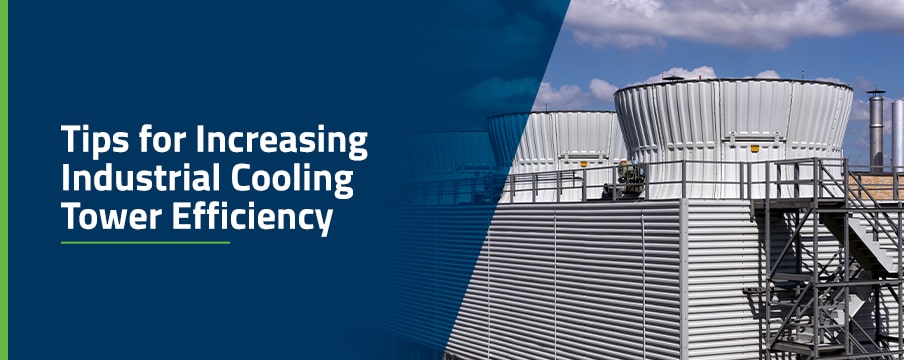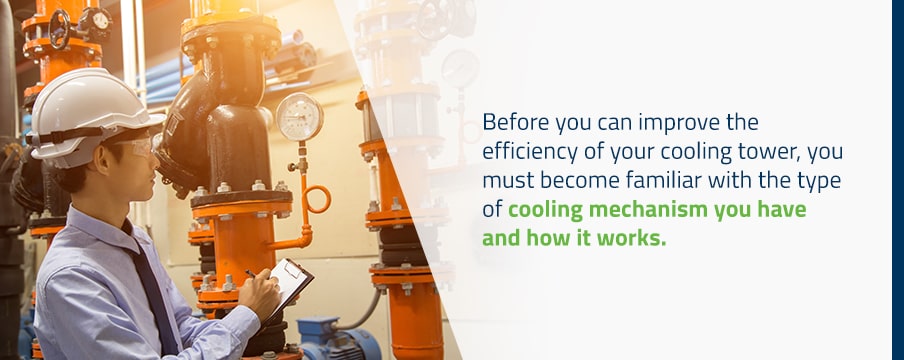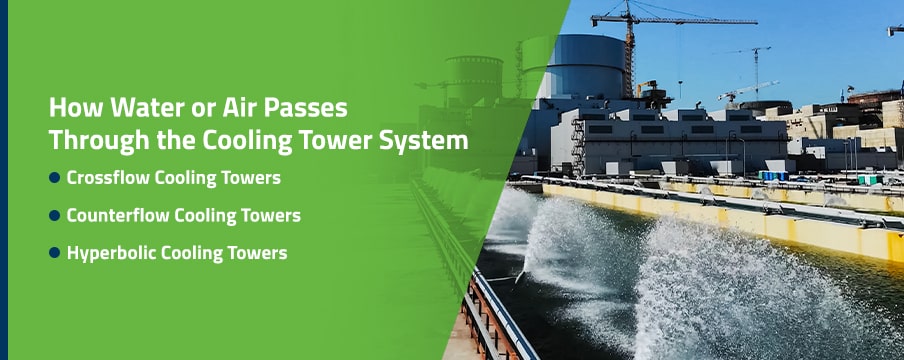
A cooling tower works by taking unwanted heat from the water and releasing it into the atmosphere. It brings cool air and warm water into contact to efficiently cool the water and reject the heat through evaporation. Cooling towers are among the most cost-effective cooling water systems available, making it vital to maintain efficiency and enhance your investment.
Cooling towers are designed to increase the surface area of the heat transfer process. Significant amounts of water must regularly pass through the system. The efficiency and longevity of these cooling mechanisms depend on the proper management and reduction of water use.
It is crucial to monitor your cooling tower efficiency so your facility can:
Federal agencies must understand how to reduce water use and improve the water efficiency of cooling towers. All losses in the water supply must be replaced by makeup water as part of a comprehensive approach to water management. Using alternative sources for cooling tower makeup water allows for other water efficiency opportunities. Explore ways to recycle and reuse water from other facility equipment with little or no pretreatment.

Before you can improve the efficiency of your cooling tower, you must become familiar with the type of cooling mechanism you have and how it works. Industrial cooling towers are typically categorized in multiple ways, with many devices falling into more than one category based on:
Different types of cooling towers are also exposed to varying contaminants and require specific treatments to run as smoothly as possible.

There are three main types of cooling towers defined by how the water or air flows through them. These types include:
Air cuts across the flowing water with lower airflow resistance, reducing fan horsepower requirements. Crossflow models use a splash fill that facilitates horizontal airflow across the water as it falls from the upper reservoirs to the bottom of the cooling tower. Gravity-fed water decks ensure water is sent to the tower fill and away from the distribution basins. While cost-effective and simple to maintain, the fill is more likely to clog with dirt and debris. Crossflow cooling towers are more vulnerable to freezing than other types.
The air flows upward against the down-flowing water so the coolest air contacts the coolest water. They provide excellent thermal efficiency and allow air to travel vertically over the splash fill. Because they cannot use gravity-fed decks with upward airflow, counterflow models have pressurized spray nozzles to spread the water across the fill.
Counterflow towers derive their name from the countering action of the air and water entering at opposite ends. They require more energy to push the air upward, leading to a higher risk of operational inefficiencies. However, counterflow cooling towers typically have a smaller footprint despite the extensive surface area. Their design makes heat transfer more efficient.
The hyperbola shape helps direct outside air upward, enhancing the cooling tower efficiency. A chimney stacking technique allows the cooler, outside air to push warmer air further inside the system. When the hot water sprays over the splash fill, it is cooled by the upward-flowing air passing through the cooling tower system. Hyperbolic units offer a sturdy foundation and require minimal resources. They are often used to manage large-scale tasks for chemical and power plants.
In addition to classifying mechanisms based on how air passes through them, there are also varieties defined solely on airflow. Cooling towers may either use mechanical pressure or natural convection to direct the flow of air.
Mechanical draft cooling towers use a fan system to push air upward into the unit. The different types of mechanical towers typically fall into one of two categories:
Natural draft or passive draft cooling towers use natural convection to move the air upwards without fans. The cool, ambient air flowing organically into the tower has a different density from the discharged warm, moist air. After contact with the hot water, the warmed air becomes less dense and rises naturally. As the cold air falls, these opposing movements create a consistent pattern of air circulation that helps cool the incoming water and reject heat through evaporation.
Counterflow and crossflow designs may be used for natural draft cooling towers, though they are more necessary for mechanical draft units. Meanwhile, hyperbolic towers are always passive draft and particularly effective at inducing adequate, natural airflow.
Once-through cooling towers draw water from a nearby source, circulate it through pipes to absorb the heat and discharge the warmed water back into the environment. These systems consume large volumes of water during the evaporation process, as steam condensers absorb the heat for comfort cooling or process cooling needs. Other types of cooling towers can use significantly less water to achieve a similar capacity.
Facilities must be located in a place with enough water to draw from. Rivers and lakes make the best sources, though it can be challenging to establish a facility if water is scarce in the area. Once-through cooling towers are generally the most cost-effective and straightforward type to install. However, local regulations may mandate how much water can be withdrawn and discharged into the environment. These rules often prevent the use of this cooling system due to the large quantity of water required.
Open loop or open recirculating cooling towers recirculate the same water throughout the process. After gathering heat, the recirculated water returns to the tower, where it is again cooled from direct contact with the atmosphere. In open circuit systems, the heat is removed with evaporation and any water that isn’t lost is continually reused.
Open loop units help reduce the amount of water required to power the system. They typically decrease the cost of chemicals needed for water treatment, too.
Cooling towers are split into two distinct categories — open loop and closed loop systems. Closed loop cooling towers, sometimes known as closed circuit or closed recirculating cooling systems, differ from open circuit units. The reused water circulates through the tower structure itself without direct exposure to the open air.
The rejected heat is transferred to a heat exchanger and circulated through the system in a coil. This way, the water doesn’t evaporate during the process, and makeup is only needed if there is a leak. Meanwhile, proper water chemistry eliminates the risk of contamination in closed circuit towers.

Cooling towers are dynamic systems. The environment they function within and the nature of their operation allow you to improve your cooling tower efficiency in various ways.
The quality of source water must meet that of the water needed to run your specific system. Different types of cooling towers may require varying water treatments depending on their operation. Areas of the cooling water process that require treatment include:
Different materials can withstand deterioration and environmental factors in different ways. Your unit may be made from various materials, so it is vital to know which material is used for which part. The manufacturer and your water treatment specialist can recommend treatments based on your cooling tower water quality to reduce corrosion risks. Without proper consideration of your unit’s material components, you may notice severe corrosion of the tower and shorter lifespans for your equipment.
Manage how water leaves the cooling tower system as a part of your comprehensive approach to water management. All losses in the water supply must be replaced by makeup water. Tracking when and how much water your system loses is essential for water conservation.
The three primary ways water can leave the cooling tower include:
Properly running cooling towers will not experience leaks or overflows in the system. However, this type of water loss is equally important when calculating how much makeup water you require.
When improving water efficiency, it is essential to maximize the cycles of concentration. Work with a cooling tower water treatment specialist to utilize the ratio of conductivity of the blowdown water compared to the makeup. This way, you minimize the quantity of blowdown and reduce the demand for makeup water.
Improve the efficiency of your chemical use to reduce corrosion and decrease the cost of chemicals used in water treatment. Work with your water treatment specialist to monitor the cooling tower chemistry and minimize the use of chemicals. Proper pretreatment of makeup water can help improve efficiency, which extends the service life of your equipment. Reverse osmosis or ion exchange can lessen the number of chemicals needed to prevent scaling and fouling.
How your cooling system works and the environment they function within may present a wide range of operational concerns. Ensure the thermal performance is efficient and reliable by addressing the four primary concerns:
Traditional water treatment programs are designed to account for various cooling system concerns. Chemical additives such as corrosion inhibitors, scale inhibitors, dispersants and biocides keep the cooling system surfaces protected and clean.
The specialists at Chardon Laboratories can help you decide the right solutions for your cooling tower water treatment. Consult with well-trained technicians who can make recommendations based on your facility’s specific needs. Our services save customers money with treatments that improve the efficiency of your process. Conserve water and energy with our help, expertise, equipment, products and services.
Keep cooling towers operating at high efficiency with closely monitored chemical water treatments and up-to-date equipment. Some vendors may be reluctant to improve your water efficiency because it will reduce the number of chemicals needed. At Chardon Labs, we don’t sell chemicals. We sell clean systems that help increase industrial cooling tower efficiency.
Our well-trained technicians provide water treatment solutions to fit our customers’ unique needs. Shop our clean cooling tower systems at a guaranteed fixed price and contact us about our customized programs today.